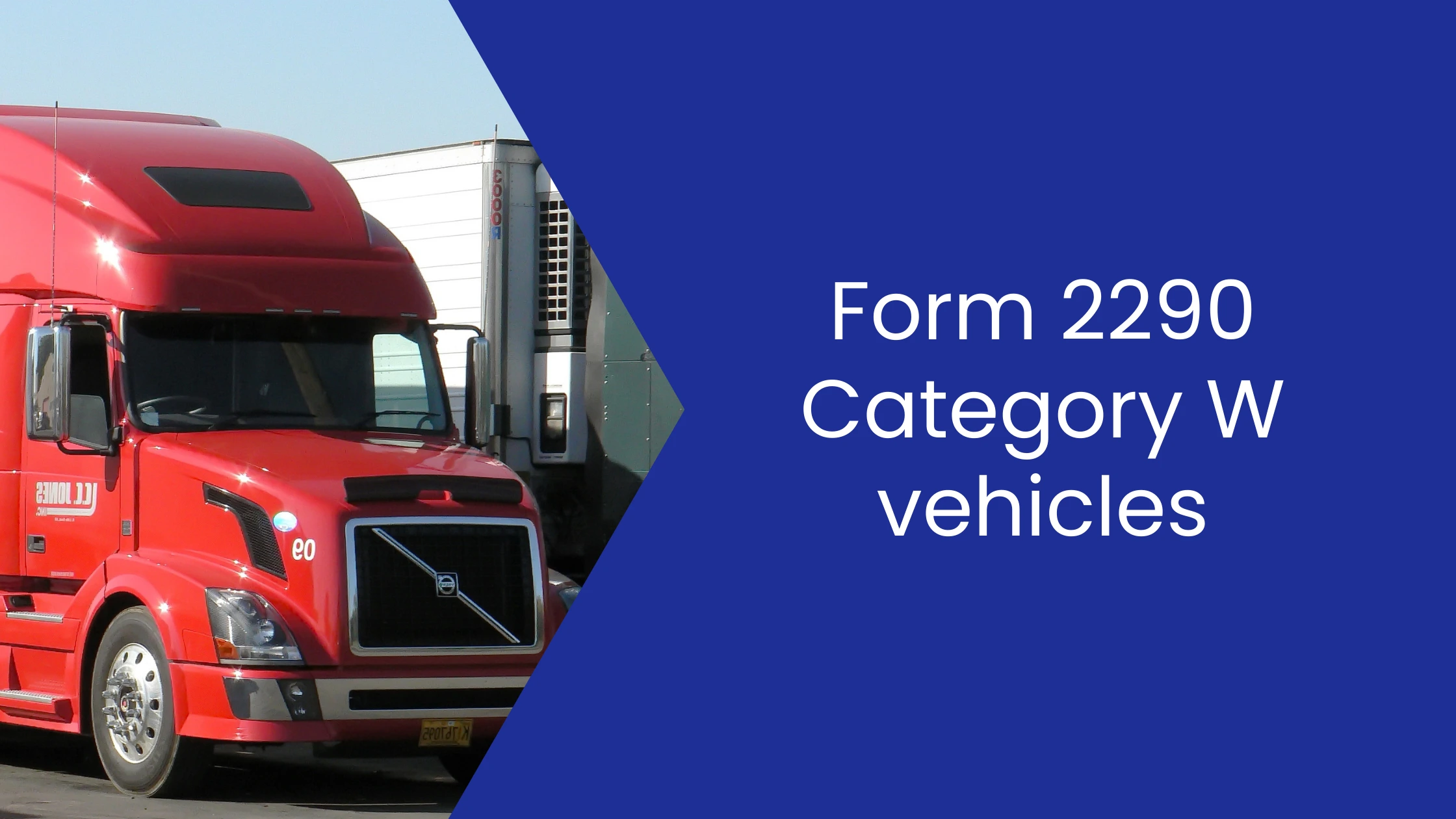09-12-2024
Form 2290 Category W
Form 2290 is used to pay the Heavy Vehicle Use Tax (HVUT) for taxable vehicles that exceed 5,000 miles on public highways. The IRS categorizes vehicles into different classes to determine the applicable tax amounts. In Form 2290, Category W refers to suspended vehicles.
What are Suspended Vehicles (Category W)?
Suspended Vehicles, categorized as Category W on Form 2290, are heavy vehicles that have not exceeded 5,000 miles on public highways (or 7,500 miles for agricultural vehicles) during the tax period. These vehicles are exempt from paying the Heavy Vehicle Use Tax (HVUT) for that specific tax period because they fall below the mileage threshold set by the IRS. Suspended vehicles are also commonly referred to as low-mileage vehicles or taxable vehicles with low mileage.
Types of Suspended Vehicles:
The IRS considers several types of vehicles as suspended for tax payment purposes under Form 2290, including:
- Logging Vehicles: These are trucks registered with the state as heavy vehicles used exclusively for transporting harvested forest products, such as logs and timber. Form 2290 Logging vehicles are exempt from HVUT if their mileage does not exceed 7,500 miles on public highways during the tax period.
- Agricultural Vehicles: Trucks registered as agricultural vehicles and used for farming purposes fall under this category. Form 2290 Agriculture Vehicles are exempt from HVUT if they do not exceed the mileage limit of 7,500 miles on public highways during the tax period.
- Government Vehicles: Vehicles owned and operated by federal, state, or local governments are classified as suspended and are exempt from HVUT. This category includes vehicles used for public safety, emergency response, and other governmental operations.
- Regular Heavy Vehicles: In addition to the specific categories mentioned above, regular heavy vehicles that have been driven less than 5,000 miles during the tax period are also exempt from paying HVUT and are considered suspended vehicles.
These suspended vehicles are exempt from the HVUT for the applicable tax period due to their low mileage use.
Should Suspended Vehicles File Form 2290?
Yes, even though suspended vehicles are exempt from tax payments, the owners are still required to file Form 2290 to indicate that their vehicles qualify as suspended. Filing Form 2290 for suspended vehicles allows the IRS to keep track of these vehicles and verify their exempt status. It is important to report suspended vehicles to ensure compliance and avoid potential penalties for failing to file.
How to fill out Form 2290 Category W?
- Complete the Declaration in Part 2: On page 3 of Form 2290, under Part 2, there is a section titled "Statement in Support of Suspension." This section must be filled out to declare that the vehicle is a suspended vehicle, meaning it is expected to be used 5,000 miles or less (7,500 miles or less for agricultural vehicles) during the tax period. Be sure to accurately complete this declaration, as it is mandatory for reporting suspended vehicles.
- Fill Out Schedule 1: In the Schedule 1 section of Form 2290, list the details of the suspended vehicles, including their Vehicle Identification Numbers (VINs) and other relevant information. Schedule 1 serves as the proof of filing and must include all the vehicles that are declared as suspended. Once completed, attach Schedule 1 to your Form 2290 for submission.
By accurately filling out these sections, you ensure that your suspended vehicles are properly reported and in compliance with IRS requirements.
Read our blog on how to file form 2290 suspended vehicles now for a comprehensive understanding.
Due date for suspended vehicles?
The form
2290 due date is the same for both taxable and suspended vehicles. The due date
is the last day of the month following the vehicle’s First Used Month (FUM).
For example, if a vehicle is first used in July, the due date to file Form 2290
would be August 31st.
What if Suspended Vehicles cross the mileage limit?
If a suspended vehicle exceeds the mileage limit of 5,000 miles (7,500 miles for agricultural vehicles), it becomes taxable. The mileage limit applies to total usage during the tax period, regardless of ownership changes.
Once the limit is exceeded:
- File an Amended Form 2290: Report the change to taxable status by the end of the month following the month the limit was exceeded.
- Pay the HVUT: Submit the required tax payment along with the amended form.
Timely filing and payment are essential to avoid penalties.
WRAP:
After reading this blog, you will gain a detailed understanding of what Category W represents in Form 2290, including the types of suspended vehicles and the steps for filing Form 2290 for these vehicles.
File 2290 Online now!
